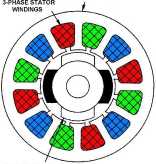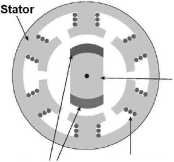8342936735

PROGRAM ROZWOJOWY
POLITECHNIKI WARSZAWSKIEJ
from the commutator, and overall reduction of electromagnetic interference (EMI). The maximum power that can be applied to a BLDC motor is exceptionally high, limited almost exclusively by heat, which can damage the magnets. BLDCs main disadvantage is higher cost, which arises from two issues. First, BLDC motors reąuire complex electronic speed controllers to run. Brushed DC motors can be regulated by a comparatively trivial variable resistor (potentiometer or rheostat), which is inefficient but also satisfactory for cost-sensitive applications. Second, many practical uses have not been well developed in the commercial sector
a)
b)
STATOR
(LAMINATED)

4-POLE PM ROTOR

Rotor
Permanent
magnets
Concentrating
winding
Fig.2.2. Crossection of the three phase BL DC motors. a) distributed winding construction. b) concentrating winding construction
BLDC motors are considered to be morę efficient than brushed DC motors. This means that for the same input power, a BLDC motor will convert morę electrical power into mechanical power than a brushed motor, mostly due to the absence of friction of brushes. The enhanced efficiency is greatest in the no-load and low-load region of the motor's performance curve. Under high mechanical loads, BLDC motors and high-quality brushed motors are comparable in efficiency.
2.1. IDEAŁ BRUSHLESS DC MOTOR WAYEFORMS
Let us suppose that the PM produces a rectangular air gap flux distribution over cą>m = % (180°) (figurę 2.3.a). Generally the surface PM extends over an angle apM less than 180° (which represent the pole pitch, Fig.2.2). The stator phase mmf is supposed to be rectangular, a case corresponding to q = 1 (three slots per pole). Consequently the PM flux linkage in the stator winding i#>m(0) varies linearly with rotor position (Fig.2.3b). Finally the phase emf Ea is rectangular with respect to rotor position (Fig.2.3c).
UNIA EUROPEJSKA
EUROPEJSKI FUNDUSZ SPOŁECZNY

^ KAPITAŁ LUDZKI
Materiały dydaktyczne dystrybuowane bezpłatnie.
Projekt współfinansowany ze środków Unii Europejskiej w ramach Europejskiego Funduszu Społecznego
19
Wyszukiwarka
Podobne podstrony:
PROGRAM ROZWOJOWYPOLITECHNIKI WARSZAWSKIEJ from the commutator, and overall reduction of electromagn
PROGRAM ROZWOJOWYPOLITECHNIKI WARSZAWSKIEJFIELDS OF STUDIES AND SPECIALIZATIONS The undergraduate st
PROGRAM ROZWOJOWYPOLITECHNIKI WARSZAWSKIEJ • Division and subject of diploma project. The division i
PROGRAM ROZWOJOWYPOLITECHNIKI WARSZAWSKIEJFIELDS OF STUDIES AND SPECIALIZATIONS The undergraduate st
PROGRAM ROZWOJOWYPOLITECHNIKI WARSZAWSKIEJ • Division and subject of diploma project. The division i
PROGRAM ROZWOJOWYPOLITECHNIKI WARSZAWSKIEJPERMANENT MAGNET AND SWITCHED RELUCTANCE
PROGRAM ROZWOJOWYPOLITECHNIKI WARSZAWSKIEJ The electrical input energy is written as: W, =Jeidt=Jidt
PROGRAM ROZWOJOWYPOLITECHNIKI WARSZAWSKIEJPERMANENT MAGNET AND SWITCHED RELUCTANCE
PROGRAM ROZWOJOWYPOLITECHNIKI WARSZAWSKIEJ The electrical input energy is written as: W, =Jeidt=Jidt
PROGRAM ROZWOJOWYPOLITECHNIKI WARSZAWSKIEJ FACULTY OF POWER AND AERONAUTICAL ENGINEERING WARSAW
PROGRAM ROZWOJOWYPOLITECHNIKI WARSZAWSKIEJ FACULTY OF POWER AND AERONAUTICAL ENGINEERING WARSAW
PROGRAM ROZWOJOWYPOLITECHNIKI WARSZAWSKIEJ FACULTY OF POWER AND AERONAUTICAL ENGINEERING WARSAW
PROGRAM ROZWOJOWYPOLITECHNIKI WARSZAWSKIEJ Figurę 2.3. Ideał waveforms for BLDC (brushless d.c. moto
PROGRAM ROZWOJOWYPOLITECHNIKI WARSZAWSKIEJ Figurę 2.3. Ideał waveforms for BLDC (brushless d.c. moto
18 ing, Spatial Planning and the Environment; from the EU and various charity funds, such as the Dut
20101121�7 gp Match the patients’ descriptions of thelr probloms włth tuHflbU technical terms from t
42 (114) 266 Chapter 7 have been received from the bank and all flight tickets have been received&nb
więcej podobnych podstron